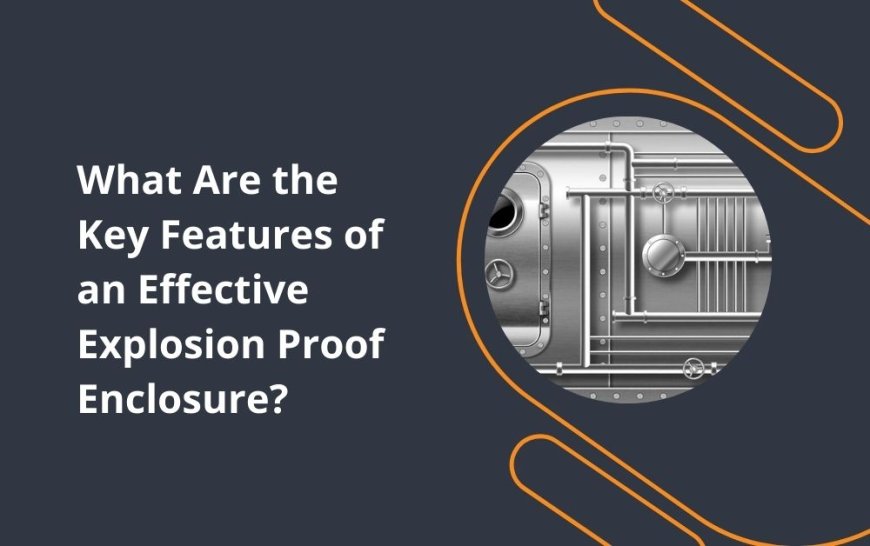What Are the Key Features of an Effective Explosion Proof Enclosure?

Ensuring safety is crucial in hazardous situations that contain explosive gasses, vapors, or dust particles. Essential parts intended to confine and lessen explosions that can happen within mechanical or electrical equipment are enclosures that are impervious to explosions. The key components of an explosion-proof enclosure that effectively protect people and property in dangerous environments are examined in this blog.
Being Aware of Explosion-Proof Enclosures
Definition and Purpose
Explosion Proof Enclosure are robust containers or cabinets designed to withstand and contain explosions that might originate from electrical or mechanical devices housed within them. Their primary purpose is to prevent the ignition of surrounding flammable atmospheres by containing sparks, flames, or hot gases generated inside the enclosure.
Construction Materials
These enclosures are typically constructed from durable materials such as stainless steel or aluminum, chosen for their ability to withstand high pressures and temperatures during an explosion. They feature reinforced walls, heavy-duty gaskets, and specialized fittings to ensure a tight seal against the entry of flammable substances.
Key Features of Effective Explosion-Proof Enclosures
Robust Design and Construction
An effective explosion-proof enclosure is characterized by its sturdy construction and durable materials that can withstand the force of an internal explosion. The enclosure should be capable of containing the blast pressure without rupturing or releasing hazardous elements into the surrounding area.
Sealing and Ingress Protection
The enclosure must have effective sealing mechanisms, such as compression glands or labyrinth seals, to prevent the ingress of flammable gases, dust, or vapors from the external environment. This ensures that any internal explosion remains contained within the enclosure, reducing the risk of secondary explosions.
Certification and Compliance
Look for enclosures that meet recognized international standards and certifications for explosion protection, such as ATEX (Europe), UL (United States), or IECEx (International). Compliance with these standards ensures that the enclosure has undergone rigorous testing to verify its ability to withstand and contain explosions under specified conditions.
Functional Aspects of Explosion-Proof Enclosures
Heat Dissipation and Ventilation
Effective heat dissipation is essential to prevent internal components from overheating and potentially igniting flammable substances. Explosion-proof enclosures are designed with adequate ventilation or cooling systems that allow heat to dissipate safely without compromising the enclosure’s integrity.
Impact Resistance and Durability
In hazardous environments, where physical impacts or environmental stresses are common, explosion-proof enclosures should be impact-resistant and durable. Choose enclosures that can withstand harsh conditions without compromising their ability to provide reliable explosion protection.
Applications and Industries

Industrial and Commercial Settings
Explosion-proof enclosures find widespread use in industries such as oil and gas, chemical processing, pharmaceuticals, and food processing, where flammable materials are handled or processed. They protect critical equipment like electrical panels, switches, and instrumentation from causing or propagating explosions.
Outdoor and Harsh Environments
These enclosures are suitable for outdoor installations or environments exposed to harsh weather conditions. They are designed to resist corrosion, moisture ingress, and temperature extremes while maintaining their explosion-proof capabilities.
Considerations for Installation and Maintenance
Installation by Certified Professionals
Ensure that explosion-proof enclosures are installed by trained and certified professionals familiar with safety protocols and installation requirements. Proper installation is crucial to maintaining the enclosure’s integrity and compliance with safety standards.
Regular Inspection and Maintenance
Schedule regular inspections and maintenance checks to verify the condition of explosion-proof enclosures. Inspect seals, gaskets, and ventilation systems to ensure they are functioning correctly and replace any damaged components promptly to uphold safety standards.
Conclusion:
Effective explosion-proof enclosures are vital components in ensuring safety and mitigating risks in hazardous environments where explosive atmospheres may be present. By understanding their key features, construction principles, and regulatory compliance, organizations can make informed decisions to protect personnel and assets from the potential dangers of explosions. Investing in high-quality, certified explosion-proof enclosures demonstrates a commitment to safety and regulatory compliance, contributing to safer working environments and operational continuity in hazardous industries.
Note:- For more articles visit on news.bangboxonline.
What's Your Reaction?

























